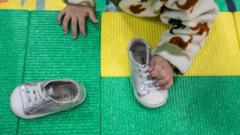In South Korea, a country grappling with the world's lowest birth rates, the fertility industry is experiencing a significant boom. With every passing week, more and more individuals are turning to fertility clinics for assistance, ignited by a societal transformation regarding family planning. Kim Mi-ae, a Seoul resident, shares her experiences of struggling with long wait times at clinics, which have become increasingly frequented since she initiated her IVF journey late last year.
Across the nation, the fertility treatment landscape has evolved, witnessing a 50% rise in procedures between 2018 and 2022, culminating in 200,000 treatments last year. Notably, one in six babies born in Seoul benefited from fertility interventions, underscoring the growing acceptance of these medical options. Experts attribute this surge to a younger generation valuing a sense of control over their reproductive lives. Women are now more proactive in freezing their eggs or seeking IVF when faced with challenges in conceiving.
The South Korean government is keen to reverse its demographic crisis, exacerbated by a rapidly aging population; currently, one in five citizens is over 65. The birth rate hit rock bottom at 0.72 in 2023, creating fears of a declining populace. However, with the slight rise to 0.75 in 2024, some optimism emerges if young people's readiness for parenthood can be rekindled.
Changing dynamics also play a role in personal stories, such as Park Soo-in, whose journey into motherhood began after marriage and observing her peers’ parenting experiences. Faced with conception issues, she, like many, has sought fertility treatments, contributing to predictions that the industry may exceed $2 billion by 2030. Jennifer Sciubba, president of the Population Reference Bureau, notes this trend highlights women still desiring children despite facing substantial barriers.
These hurdles are extensive, encompassing both societal expectations that place caregiving responsibilities predominantly on women and financial strains linked to long working hours and educational expenses. The average age of mothers at first childbirth is now a confronting 33.6 years, leading many to express regret about not starting a family sooner.
The financial burden of assisted reproduction is substantial, with South Korea's investment in subsidizing fertility treatments often overshadowed by high out-of-pocket expenses. Women like Jang Sae-ryeon have endured the emotional and financial strains that accompany multiple IVF cycles, voicing their frustrations over professional commitments that hinder their ability to pursue treatments effectively.
Despite the myriad challenges, aspirations to build families persist. Jang recalls her losses and articulates her hopes for future motherhood, emphasizing the deep emotional fulfillment it would bring. As South Korea navigates its evolving fertility landscape, it becomes evident that behind each statistic lies a story of longing, persistence, and the relentless pursuit of familial bonds amidst societal pressures.
Across the nation, the fertility treatment landscape has evolved, witnessing a 50% rise in procedures between 2018 and 2022, culminating in 200,000 treatments last year. Notably, one in six babies born in Seoul benefited from fertility interventions, underscoring the growing acceptance of these medical options. Experts attribute this surge to a younger generation valuing a sense of control over their reproductive lives. Women are now more proactive in freezing their eggs or seeking IVF when faced with challenges in conceiving.
The South Korean government is keen to reverse its demographic crisis, exacerbated by a rapidly aging population; currently, one in five citizens is over 65. The birth rate hit rock bottom at 0.72 in 2023, creating fears of a declining populace. However, with the slight rise to 0.75 in 2024, some optimism emerges if young people's readiness for parenthood can be rekindled.
Changing dynamics also play a role in personal stories, such as Park Soo-in, whose journey into motherhood began after marriage and observing her peers’ parenting experiences. Faced with conception issues, she, like many, has sought fertility treatments, contributing to predictions that the industry may exceed $2 billion by 2030. Jennifer Sciubba, president of the Population Reference Bureau, notes this trend highlights women still desiring children despite facing substantial barriers.
These hurdles are extensive, encompassing both societal expectations that place caregiving responsibilities predominantly on women and financial strains linked to long working hours and educational expenses. The average age of mothers at first childbirth is now a confronting 33.6 years, leading many to express regret about not starting a family sooner.
The financial burden of assisted reproduction is substantial, with South Korea's investment in subsidizing fertility treatments often overshadowed by high out-of-pocket expenses. Women like Jang Sae-ryeon have endured the emotional and financial strains that accompany multiple IVF cycles, voicing their frustrations over professional commitments that hinder their ability to pursue treatments effectively.
Despite the myriad challenges, aspirations to build families persist. Jang recalls her losses and articulates her hopes for future motherhood, emphasizing the deep emotional fulfillment it would bring. As South Korea navigates its evolving fertility landscape, it becomes evident that behind each statistic lies a story of longing, persistence, and the relentless pursuit of familial bonds amidst societal pressures.


















